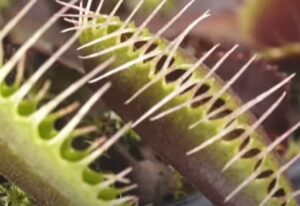As an Amazon Associate, this site earns commissions from qualifying purchases. For more details, click here.
Have you ever seen an insect get trapped in a sundew, yet its leaves do not seem to close over it? Is this a sign that something is wrong with your plant? If you have a sundew or want to buy one, understanding its feeding habits is essential. This guide will explain why some sundews take longer to close over food than others.
Sundews can take 10 minutes to an hour to fully close over food. However, some variants like Drosera burmannii and Drosera glanduligera have snap tentacles that can wrap around its prey in less than a second.
How Fast Sundews Close: Speed Comparison
Sundews variants catch prey the same way, luring them with the dew and trapping with their tentacles. But how long this process takes will depend on the species.
- Most sundew tentacles like D. capensis and D. admirabilis take at least 10 minutes to clover over a prey.
- D. glanduligera does it in a second or even less. The same with D. burmannii.
- D. capensis for instance, curls its leaves in a day or less.
- D. regia requires several days.
- Pygmy sundews take several minutes to curl over a trapped insect.
- Most sundew variants in South America require several hours to trap a prey.
Regardless of the speed difference, virtually all sundews will cover up its prey. The only exception is if it is too large or the plant is sick.
The speed comparisons above assume the sundew is healthy. If your plant does not have access to insects, you can fed it Zoo Med Micro Floating Betta Pellets as they are also nutritious.
Two factors also affect the trapping and curling speed: the insect and snap tentacles. The more a prey tries to escape, the faster the leaves will curl. Sundews with snap tentacles also curl up faster.
The snap tentacles on sundews like D glanduligera do not have mucilage. These highly sensitive tentacles are right on the borders of the leaf, and when they catch a prey, hurl it into the sticky parts.
How fast are these snap tentacles? In the case of D. burmannii it is just a few seconds. With D. glanduligera these tentacles can snap in 75 milliseconds, the fastest for any sundew variant.
How D. glanduligera manages to close so fast is still unknown. But researchers theorize that the process has something to do with hydraulic pressure which allows the snap tentacle to function like a catapult.
How Sundews Close and Catch Insects
Sundews produce a sticky morning dew-like substance (mucilage) to lure insects. Because sundews grow in nutrition poor soil, they try to get nutrients from other sources around them.
When an insect lands on the sticky dew, one of the tentacles will wrap itself around the bug. Some variants like D. glanduligera are equipped with long tentacles that snap its prey into the dew.
The trapped insect is then pulled into spoon shaped leaves where it is consumed. The plant releases digestive enzymes to dissolve the bug. This allows the plant to absorb its prey in liquid form along with its nutrients.
While there are some differences with the tentacles, the basic trapping method is the same for all sundews. Unlike Venus flytraps, the tentacles do not need any stimulation. You can drop a living or dead bug and it makes no difference, the plant will eat it.
This also means you can buy freeze dried food like Picky Neb Dried Mealworms for the plant. You can drop the food onto the tentacles or any sticky area. Whereas with Venus flytraps you have to stimulate the hair sensors, with sundews there is no need.
Whether the sundews have snap tentacles or not, they always use mucilage to lure insects. It bears a striking resemblance to morning dew, but it has a mucus or glue-like consistency. It hardly sticks to your finger and if it does you can pull it out.
For bugs however the trap is fatal. A trapped insect can die from exhaustion trying to escape or from suffocation. Either way it does not matter to a sundew plant because its tentacles eat living and dead prey.
Is My Sundew Slow or Not Closing Over Prey?
So you just bought a sundew and was lucky enough to see it catch a bug. However it has been several hours and its leaves have not covered it up. Is there something wrong?
Sundews only move their leaves when fed large amounts of food. Only the tentacles will move if the plant is fed small bits. Some sundew variants such as D. schizandra and D. binata do not move their leaves at all.
But even other variants that usually have leaf movement like D. burmannii and D. capensis will only move their tentacles if food is in small amounts. This is true for almost all sundews.
To recap: sundews use dew to capture prey. This sticky substance is found on the tips of its tentacles and various parts of the plant.
When a bug lands on the dew, one of the tentacles will enfold it. This can take seconds or several minutes depending on the variant.
If the food is large enough, the tentacle will move the object into the leaves to be digested. The leaves will curl up over the food and release digestive enzymes.
This can take anywhere from several minutes to several days. The easiest way is to check what sundew variant you bought. This will give you an idea how long it takes to close, what to feed it, growth instructions etc.
If your sundews are taking too long to close, the plant may already be full. Sundews only feed on insects when they need to. Once their nutritional requirements are met, the plant will not consume anymore.
It is a different story if the plant looks unhealthy. If its leaves are turning black and withering, it is a sign of infection and needs to be treated.
How to Keep Your Sundew Healthy
There are several things you can do to keep your sundews alive and healthy. Here are some guidelines.
- Know the variant. The more you know, the easier it is to diagnose a problem. Knowledge about the species makes it easier to grow the plant and avoid mistakes.
- Pick an easy sundew to grow. Cape sundews is best for beginners as they do not go into dormancy.
- Learn as much as you can about their feeding habits. As has been shown here, some sundews take longer to close than others. Knowing the time it takes for tentacles and leaves to curl is essential to avoid making hasty judgments about its condition.
- Follow the instructions that came with your sundews. This is particularly important for seedlings. Care and handling will depend on the region. That is, tropical sundews do not go into dormancy, while some temperate sundews do.
There are four facets to growing sundews: light, water, nutrients and soil. Each one needs to be done properly.
- Sundews need at least 6 hours of sunlight, 12 hours is ideal. Direct sunlight is fine as long as it is not too hot. Grow lights are also effective for indoor cultivation.
- Use only reverse osmosis, purified water or rainwater. Water the plant to keep the soil moist, but do not drench it as you risk overwatering sundews.
- Do not plant in regular potting soil. Fertilized soil is harmful to sundews and other carnivorous plants. The standard option is 1:1 peat moss and perlite or 1:1 long sphagnum moss and silica sand.
- Nutrients: flies, mosquitoes, spiders, freeze dried worms, fish food, crickets, any of these will be fine. Just make sure the food bits are small enough for the plant.
Conclusion
Because sundews come in different variants, it should come as no surprise that their trapping speed varies. By knowing what type you have and its feeding habits, you will have a good idea of how long it is going to take for the tentacles to enfold a prey.

My fascination with carnivorous plants began many, many years ago with Venus Fly Traps. Now I am more than happy to impart what I know with other enthusiasts and those who are curious about meat eating plants.



